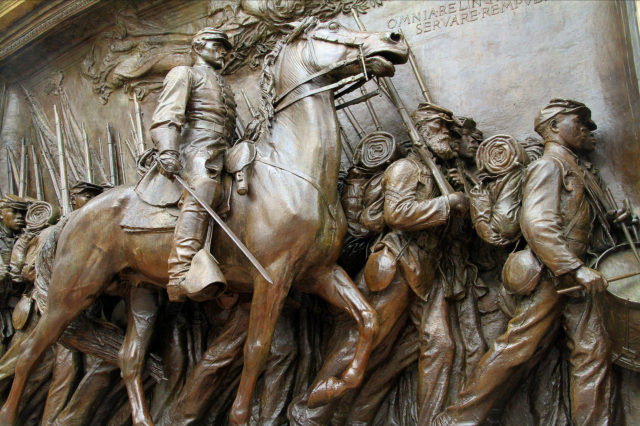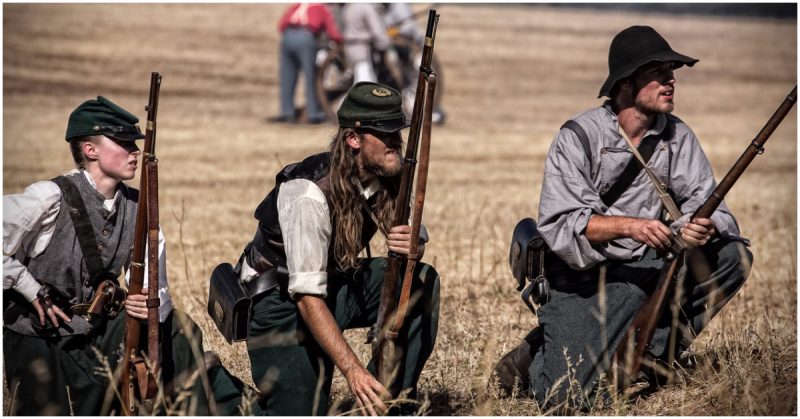The recruitment of African-American soldiers was one of the most important moments in the American Civil War. In practical terms, it provided soldiers for the Union Army. Symbolically, it emphasized the fight to end slavery and make all men equal.
The most famous unit both then and now, was the 54th Massachusetts Regiment, the heroes of the film Glory.
The Question of Black Soldiers
The issue of slavery was fundamental to the American Civil War. Although Lincoln did not become president on an abolitionist platform, he was widely known to favor abolition. His presidency stirred the southern states to take up the cause of self-determination and secede, forming the Confederacy.
In practical terms as well as those of principle, slavery was important. It fuelled the southern plantation economy, while technology and free men powered the northern industry.
At the start of 1863, the Emancipation Proclamation made clear the Union’s intention to free slaves in the south. Slavery had not been abolished in Northern slave states and was still a contentious issue. The idea of arming African-Americans was even more controversial. Many feared arming them would lead to social upheaval. Others believed they were incapable of fighting as well as white men.
The Union was no idyllic haven of equality.
Quiet Advances: Before the 54th
Steps had already been taken to arm African-Americans. General Ulysses S. Grant, one of the powerhouses of the Union war effort, advocated for African-American troops. Lincoln, the emancipator, was in favor but he knew he had to tread carefully to keep the Union together against the Confederacy.
In the fall of 1862, the War Department quietly gave permission to a few commanders to raise African-American units. In the Mississippi Valley, the Kansas-Missouri border, and the South Carolina Sea Islands, the first of these regiments appeared. It was a chance to see how they would perform and how people around them would react.
The results were promising. In May and June 1863, four of those regiments earned praise for their efforts in the Vicksburg campaign.
Having dipped its toe in the water, the Union was ready to commit to African-American troops.
Founding the Regiment
In February 1863, John Andrew, the Governor of Massachusetts, took a bold step. He began organizing an African-American regiment, the 54th Massachusetts. It was the first such unit to be raised in the public eye.
Bold as the move was, it had its limits. To make the unit acceptable to the white public, it had to have white officers. To ensure their commitment to what the unit represented, Governor Andrew sought out officers who strongly opposed slavery.
By May 1863, the unit was fully trained and marched toward the front.
Who Were Those Men?
Command of the new regiment went to Robert Gould Shaw. Shaw came from a staunchly abolitionist family, part of New England’s social elite. He was a Harvard graduate with every advantage that could come to a young man of his background. He was also a combat veteran, having fought in the early years of the war.
Many of Shaw’s fellow officers were also veterans. They gave up better positions to lead the 54th, a post which brought stigma due to the racism ingrained in society.

Most of the soldiers were not ex-slaves. They were African-Americans who had lived their whole lives free in the north. Some came from prominent families. Frederick Douglas’s son Lewis was the sergeant major, and one of his brothers served alongside him. Garth Wilkinson James, the brother of William and Henry James, served as adjutant and was injured in the unit’s first serious action.
Although they were free, they had faced racism throughout their lives. Robert Simmons, a sergeant, lost a nephew to a racist attack in New York three days before he was fatally injured in combat.
Fort Wagner
The 54th Massachusetts Regiment’s first and most famous action took place at Fort Wagner.
A massive beachhead fortification, it defended the southern approach to Charleston. To attack it, the Union forces had to advance along several hundred yards of exposed beach, caught between the ocean and swamps.
At dusk on July 18, 1863, the 54th Massachusetts attacked. Even as darkness descended, they were terribly exposed. Shells rained down on them. Musket fire ripped through their ranks. Many men fell long before they reached the walls.
Despite their losses, they reached the ramparts and broke through onto the parapet.
The strength of the defenders and their positions, however, proved too much. The 54th were driven back with terrible losses. Shaw was among the dead. James and Simmons were both injured, Simmons fatally.
Reactions to Fort Wagner
The assault on Fort Wagner proved two things. One was that an infantry attack could not take the Fort. The other was that an African-American soldier could fight as well as any white man. The courage and determination of the 54th became a powerful symbol, widely reported in northern newspapers.
The Confederates buried the dead with contempt in an unmarked mass grave. Many in the north were shocked to hear that Shaw, a white man, had been buried among his African-American soldiers. When the Fort was captured, a Union officer offered to find Shaw’s body for a separate burial. Shaw’s father refused, leaving his son’s remains amongst the men he had fought alongside.
Fighting On
The 54th Massachusetts fought in many other engagements. Inspired by their example, more African-American regiments were raised. Instead of a background role in service and labor battalions, as had initially been intended, they became front line soldiers.
It was their first public example of courage that changed hearts in the north. It forever shaped the place of African-American soldiers in the United States Military.
Source:
James M. McPherson (1996), Drawn With the Sword: Reflections on the American Civil War
